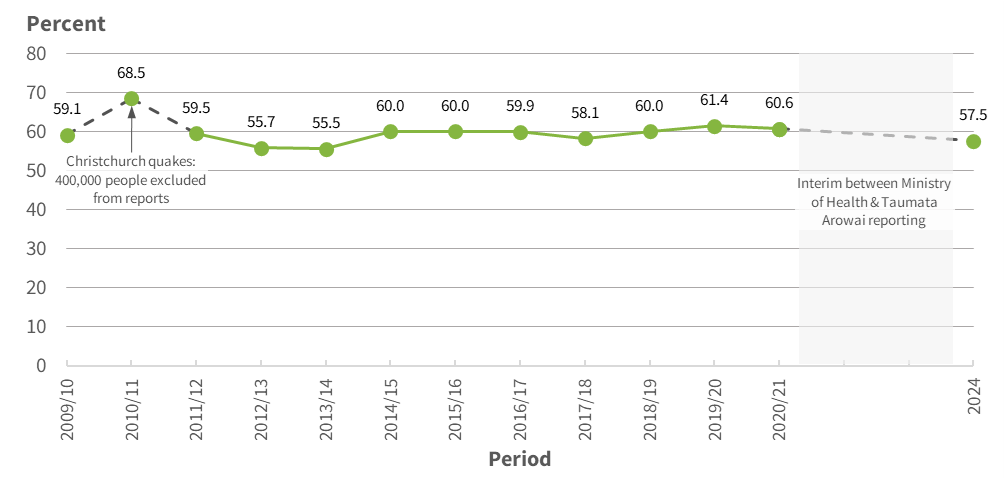Access to fluoridated drinking-water
This indicator presents information about the population with access to fluoridated drinking water in Aotearoa New Zealand.
On this page:
Background information
Tooth decay (dental caries) is a major chronic disease among New Zealanders of all ages. It is often accompanied by pain, infection, and tooth loss, and can lead to absence from work or school (OPMCSA). Dental caries (cavities) are caused by acids that are produced by bacteria in the mouth. The acids dissolve the hard enamel of the tooth surface and start dental decay. A high-sugar diet can raise the number of bacteria, which in turn increases the production of decay-causing acids (Ministry of Health 2010; OPMCSA).
Fluoride is known to protect teeth against dental caries, so adding fluoride to drinking water supplies can help limit tooth decay. Fluoride works to protect teeth in three ways (OPMCSA 2021):
- strengthening of tooth enamel, making teeth more resistant to decay
- interference with the growth of bacteria that cause cavities
- repair of the early stages of tooth decay.
About 60% of New Zealanders have access to fluoridated drinking water
About 4.3 million New Zealanders (81% of the population) received water from registered drinking water supplies that were reportedly fluoridated as of July 16th 2024. The remainder received water from very small community supplies (typically serving fewer than 100 people) or sourced their own water from ‘self-supplies’ (eg, rainwater tanks). Of the population on registered supplies, 57.5% (2.5 million) had access to fluoridated drinking water. From 2014/15 onwards, this percentage of people with access to fluoridated water has remained largely unchanged, never going above 62% (Figure 1).
Figure 1: Percentage of the population on registered drinking-water supplies with access to fluoridated drinking water, 2009/10–2024

Notes: The grey zone around the 2010/11 reporting period indicates that this is considered an outlier and should not be used when interpreting the overall percentage of people with access to fluoridated drinking water. The change in the regulatory body associated with collecting this data changed the periods with which the data points are associated. Data reported by the Ministry of Health refers to a July-June annual reporting period. Data from Taumata Arowai (2024 onwards) is a snapshot of the verified water supplies recorded in Hi at the time EHINZ received the data.
Information about this indicator
The datasets for this indicator come from the Ministry of Health’s ‘Annual report on drinking-water quality’ (prior to 2024) and Taumata Arowai's 'Public Register of Drinking Water Supplies'.
References
-
Ministry of Health. 2022. Annual report on drinking water quality 2020-2021. Wellington: Ministry of Health.
-
Office of the Prime Minister’s Chief Science Advisor (OPMSCA). 2021. Fluoridation: an update on evidence. Wellington: Office of the Prime Minister’s Chief Science Advisor.
- Taumata Arowai. 2024. Extract from the public register of drinking water supplies. Wellington: Taumata Arowai (Personal communication with Taumata Arowai analysts)
